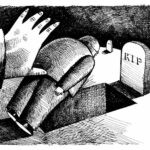Canadian Politics, MAiD / Euthanasia
The death count of Canada’s euthanasia regime surpasses 30,000–and the trajectory is straight up
Yet another long analysis of Canada’s euthanasia regime has been published, this time by The Walrus, a Canadian magazine. It reads like a laundry list of disability, mental health, and even addictions groups that oppose the consistent expansion of the eligibility requirements; even those who supported the initial regime are opposed to the Trudeau government’s expansions. And yet—and it is hard not to be helplessly angry about this—the government seems to be entirely deaf to the concerns of these communities.
Only one of the groups interviewed for the article is Christian—we are approaching near-consensus when it comes to opposing expanding eligibility requirements for euthanasia. And yet, no matter how loud disability advocates and mental health professionals shout and beg and plead, the government continues to move forward, and the bodies of the desperate continue to pile up.
A few excerpts highlight just how bad it is getting. Canada’s euthanasia regime was once supported by the experts, journalist Meagan Gillmore noted. But then the Trudeau government indicated that it was planning to expand eligibility:
That rosy perception began to darken when, in 2021, the legislation was expanded to include people whose deaths are not considered reasonably foreseeable—an option now known as Track Two. The development particularly angered many disabled Canadians. The change in legislation made it possible for disabled people to qualify for MAID even if they weren’t terminally ill. Over the past year, according to news reports, people have considered applying for or have died by MAID for reasons such as insufficient housing and meagre social supports that have left them in perpetual poverty. Carlson knows people with disabilities who have applied for MAID because they couldn’t find proper supports to live. “Canada has made it so that it’s become the only resource or recourse that people who are marginalized or poor have,” she says.
That is precisely what many of those applying for euthanasia have said. I’ve spoken to some myself. Many see euthanasia as the only way out of difficult circumstances, and cite a complete lack of support. One of the only safeguards the government has implemented for the incoming expansion of eligibility to those suffering from mental illness is a 90-day waiting period—but experts have dismissed this as woefully inadequate:
But ninety days isn’t long enough for comprehensive reflection, says Virginia Duff, a Toronto-based psychiatrist. Most people, she says, would not likely reverse or even reconsider such a decision within that time frame. This is especially true, she adds, for people who have recently acquired a disability and are adjusting to its impact on their lives. “They’re in a crisis at the beginning,” says Duff. “They’re going to be regarding their future in a certain light and often in a negative light. But they don’t know at that point what they don’t know. And they don’t know that life with a disability can be very different from what they imagined it to be.”
Again: Why are these experts ignored? It is difficult to understand why a handful of suicide activists with groups like Dying with Dignity are overriding the concerns of so many advocates for the vulnerable. One academic put it bluntly:
“Canada has become a poster child for how bad MAID can become,” says Heidi Janz, a long-time disability rights activist and playwright. An associate adjunct professor at the University of Alberta, she studies and teaches the ethics around end-of-life care and disability. Janz, along with Catherine Frazee, a professor emerita of disability studies at Toronto Metropolitan University, started the GRIM Project in 2022 to document the stories of disabled people who have considered MAID or have died by it. (Both Janz and Frazee appeared as witnesses for the AMAD committee, as well as several other sources I interviewed for this story.) The project takes its name from the Criminal Code’s language of a “grievous and irremediable condition.” Janz and Frazee have spent years listening to the stories of disabled Canadians, many of whom live in poverty and struggle with social isolation. MAID, says Janz, “has become an acceptable solution to poverty for people with disabilities.”
“These problems predate the MAID system,” says Frazee. She frequently hears stories of disabled Canadians turning to MAID out of desperation and thinks about them every day. They tell her they don’t want to die yet the government seems to be pushing them to. “But the MAID system makes it all a perfect crime because the MAID regime destroys the evidence,” she says. “It destroys the lives of the people who were here to report their experience of poverty and alienation and stigmatization and devaluation.”
The inevitable consequence of all this is that more and more Canadians will opt to die by lethal injection—the death count of the euthanasia regime has already surpassed 30,000 since legalization. One euthanasia provider put it bluntly. “There’s been an increase already in the past seven years in MAID across the country,” she told The Walrus. “It doesn’t look like that trajectory is stopping.”
It won’t—unless we stop it. Readers of this blog will know that I am no great fan of the Conservative Party of Canada. But right now, the CPC is the only party calling for a halt to the expansion in eligibility for euthanasia, and the only party opposing assisted suicide for mental illness. It is no exaggeration to say that this current government’s policies are an active threat to the lives of those we love who are suffering with mental illness. If given the opportunity, the Trudeau government will not only continue on this trajectory—they will torque it.








